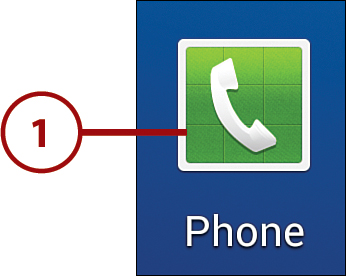How to Find Advanced Settings on Galaxy S4
This chapter is from the book
Changing System Settings
By changing preferences in Settings, you can make the phone look and work to match your needs. Although system and app settings are discussed throughout the book, this section points out some settings that aren't mentioned elsewhere but are important in customizing your phone.
To access system settings, go to the Home screen, press the Menu key, and tap Settings. To access an app's settings (for those that provide them), launch the app, press the Menu key, and tap Settings.
Setting the Date and Time
In Date and Time Settings, when the Automatic Date and Time and Automatic Time Zone settings are enabled, date, time, and time zone information is automatically obtained from the network. To change these settings, open Settings, select the More tab, and tap Date and Time.
If necessary, you can override this information by disabling the two Automatic settings and then making changes to the Set Date, Set Time, and Select Time Zone items. Tap Select Date Format if you want to change the format for displaying dates.
Enabling Motion and Palm Motion Settings
You can selectively enable Motion and Palm Motion settings to control phone features by tilting, shaking, or making special movements with the phone.
-
On the Home screen, press the Menu key and tap Settings.
-
Select the My Device tab. Scroll to the Input and Control section, and tap Motions and Gestures.
- Move the sliders to On or Off to control the three categories of motions and gestures: Air Gesture, Motion, and Palm Motion. Tap Gyroscope Calibration to start a calibration routine for the phone's gyroscope.
-
Tap Motion to enable or disable the various Motion settings.
- To use any of the motion features, you must set the Motion switch to On. Similarly, you can simultaneously disable all motion features by setting the Motion switch to Off.
-
When the Motion switch is On, the individual Motion settings work as follows:
- Direct Call. When viewing a person's contact record, you can move the phone to your ear to place a call to the person.
- Smart Alert. When you pick up the phone, you're notified of missed calls or messages.
- Zoom. When viewing an image in Gallery or a web page in the Internet app, place two fingertips on the screen, and tilt the phone toward you to zoom in or away from you to zoom out.
-
Browse an Image. Press and hold an onscreen image in Gallery to pan within it by tilting the phone up, down, left, and right.
- Mute/Pause. Mute incoming call ringtones or pause playing media by turning the phone over so that it's face down.
-
Tap the Settings icon or press the Back key to return to the Motions and Gestures screen.
-
Tap the Palm Motion text to view the Palm Motion settings.
- To use either of the Palm Motion features, you must set the Palm Motion switch to On. (You can turn both features off at once by setting the Palm Motion switch to Off.)
-
The Palm Motion settings work like this:
- Capture Screen. Create screen captures by placing the edge of your hand on the screen and dragging across it. Captured screens are saved in the Screenshots folder. (You can also create screen captures by simultaneously pressing the Home key and Power button.)
-
Mute/Pause. Mute audio or pause video by covering the touchscreen with your palm.
Enabling Air Gesture
The Air Gesture feature enables you to control your phone by gesturing over the sensor at the top of the screen—without touching the screen.
-
Tap the Air Gesture text on the Motions and Gestures screen.
- To use any of the Air Gesture features, you must set the Air Gesture switch to On. When you want to turn off all the Air Gesture features, move this switch to Off.
-
When the Air Gesture switch is On, the individual Air Gesture settings work as follows:
- Quick Glance. When your phone's screen is off, move your hand over the sensor at the top of the screen to display information such as notifications, missed calls, unread messages, and battery level. To choose which information appears, tap the Quick Glance text and select check boxes in the scrolling More Information list.
-
Air Jump. When viewing a web page or an email message, wave your hand up or down over the sensor to scroll up or down by a screenful of text.
- Air Browse. When playing music, viewing pictures, browsing pages in the Internet app, or working in S Memo, move your hand left or right above the sensor to move to the next or previous item. To choose the apps in which Air Browse works, tap the Air Browse text, and then select check boxes in the scrolling Supporting Applications list.
- Air Move. When working on the Home screen, in the App list, or in Day or Week view in Calendar, tap and hold an item on screen with one hand, and then wave the other hand to the left or right over the sensor to move the item to another page.
- Air Call-Accept. When you receive an incoming call, wave your hand over the screen to accept it.
Setting Ringtones
A ringtone is an audible event notification, such as a sound effect or a snippet of music. You can specify default ringtones for incoming calls and text messages, as well as set person-specific ringtones for anyone with a Contacts record.
Setting the Default Incoming Call Ringtone
Unless overridden by a personal or group ringtone, the default ringtone plays to notify you of an incoming call.
-
On the Home screen, press the Menu key and tap Settings.
-
Select the My Device tab, and tap Sound.
-
Tap Ringtones.
-
The Ringtones dialog box appears, showing a scrolling list containing all built-in, created, and downloaded ringtones. Tap a ringtone to play it. When you're satisfied with your choice, tap OK.
Setting the Default Notification Ringtone
Unless overridden by a personal or group ringtone, the default notification ringtone plays to signify new email, a text message, a missed call, a waiting voicemail, or an upcoming Calendar event. Unlike call ringtones, notification ringtones are brief and less intrusive.
- Perform steps 1–2 from the previous task ("Setting the Default Incoming Call Ringtone").
-
On the Sound setting screen, tap Notifications.
-
The Notifications dialog box appears, showing a scrolling list containing all the notification ringtones. Tap an entry to play it. When you're satisfied with your choice, tap OK.
Assigning a Ringtone to a Contact
To make it easier to quickly recognize an incoming call from a person, you can associate a distinctive ringtone with his or her record in Contacts.
-
On the Home screen, tap the Contacts icon.
-
With the Contacts tab selected, find the person's record by scrolling or searching. Tap the record to open it.
-
Scroll to the Ringtone section of the record, and tap the ringtone entry.
-
Select the ringtone that you want to use and tap OK. Select Default Ringtone (at the top of the list) only if you want to use the default ringtone for this contact.
-
The selected ringtone is associated with the person's contact record.
Assigning a Ringtone to a Contact Group
You can also associate a distinctive ringtone with all members of a contact group. (To learn about groups, see "Working with Contact Groups" in Chapter 5.)
-
On the Home screen, tap the Contacts icon.
-
Tap the Groups tab to display the list of defined groups, and tap a group to show its members.
-
Press the Menu key and tap Edit.
- Tap Group Ringtone and select a ringtone as described in step 4 of the previous task ("Assigning a Ringtone to a Contact").
-
Tap the Save button.
Assigning a Default Messaging Ringtone
You can also select a ringtone to announce new text and multimedia messages.
-
On the Home screen, tap the Messaging icon.

-
On the main Messaging screen, press the Menu key and tap Settings.
-
Scroll to the Notification Settings section, and tap Select Ringtone.
-
Select a sound effect from the scrolling list and tap OK. (If you'd rather not have a messaging ringtone, select Silent.)
Personalize Your Call Sound
You can personalize the call sound by adjusting the sound balance. This enables you to compensate for hearing loss in one or the other ear or in the upper or lower ranges.
-
On the Home screen, tap the Phone icon.

-
In the Phone app, press the Menu key and tap Call Settings.
-
Tap Personalize Call Sound.
-
Do either of the following:
- To set up a personalized sound balance, tap Adapt Sound and perform the remaining steps in this task.
-
Tap Soft Sound, Clear Choice, or Off, and skip the remaining steps.
-
Plug in your headphones, put them in or on your ears, and tap Start.
-
Listen for the tones your phone is playing. Tap Yes if you can hear each tone; tap No if you cannot.
- On the Adapt Sound screen that appears at the end of the test, tap Left or Right to see a graph of the results for that ear.
- Tap Preview Adapt Sound to hear audio with the adaptation applied. If the result isn't satisfactory, tap Retry to go back to step 5 and try again.
- Optional: In the Adapt Sound Settings section of the screen, tap check boxes to indicate where you want to enable Adapt Sound—on phone calls and/or when playing music. If you tend to use one ear when you're on calls, tap Frequently Used Side and select your favored side.
-
Tap Done when you are satisfied with the results.
How to Find Advanced Settings on Galaxy S4
Source: https://www.informit.com/articles/article.aspx?p=2128063&seqNum=3
0 Response to "How to Find Advanced Settings on Galaxy S4"
Post a Comment